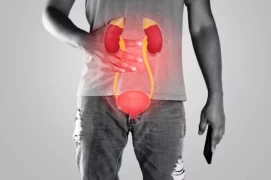
ESWL Method for Breaking Kidney Stones
- ESWL Method for Breaking Kidney Stones
- What is Kidney Stone?
- How Does Kidney Stone Form?
- What are the Kidney Stone Breaking Methods?
- What is the ESWL Method?
- What are the Advantages of ESWL Method over Other Methods?
- What are the Disadvantages of the ESWL Method to Other Methods?
What is Kidney Stone?
A kidney stone is a hard, crystalline mineral deposit that forms in the kidney or urinary tract. Kidney stones can be small and pass through the urinary tract without causing symptoms, or they can be large and cause severe pain and other complications.
The most common type of kidney stone is made of calcium oxalate, but other types can also form, including uric acid stones, struvite stones, and cystine stones.
Factors that can increase the risk of developing kidney stones include dehydration, a diet high in protein or salt, a family history of kidney stones, certain medical conditions such as gout or inflammatory bowel disease, and certain medications.
Symptoms of kidney stones can include intense pain in the back or side, nausea and vomiting, blood in the urine, and difficulty urinating. Treatment options for kidney stones may include medications to manage pain and help the stones pass, as well as procedures to remove or break up larger stones. Prevention strategies may involve increasing fluid intake, dietary modifications, and medication to decrease stone formation.
How Does Kidney Stone Form?
Kidney stones form when there is a high concentration of certain substances in the urine, such as calcium, oxalate, uric acid, and cystine. These substances can crystallize and stick together, forming a solid mass that can grow in size and cause pain and other symptoms.
- There are several factors that can contribute to the formation of kidney stones:
- Dehydration: When the body does not have enough water, the urine becomes concentrated and minerals are more likely to crystallize and form stones.
- Dietary factors: A diet high in animal protein, salt, and oxalate-containing foods (such as spinach, rhubarb, and chocolate) can increase the risk of kidney stone formation.
- Medical conditions: Certain medical conditions such as hyperparathyroidism, gout, and inflammatory bowel disease can increase the risk of kidney stones.
- Genetics: Some people are more prone to developing kidney stones due to inherited conditions that affect how the body processes certain substances.
- Medications: Certain medications, such as diuretics and calcium-based antacids, can increase the risk of kidney stone formation.
Once a kidney stone forms, it can grow larger and potentially block the flow of urine, causing pain and other symptoms. Prompt medical attention is important to prevent complications and manage symptoms.
What are the Kidney Stone Breaking Methods?
There are several methods for breaking up or removing kidney stones, depending on the size, location, and type of stone. Here are some common methods:
- Extracorporeal shock wave lithotripsy (ESWL): This is a non-invasive procedure that uses shock waves to break up the stone into small pieces that can be passed in the urine. ESWL is usually used for small to medium-sized stones.
- Ureteroscopy: This is a minimally invasive procedure that uses a thin, flexible scope to visualize and remove the stone. A small instrument is inserted through the scope to break up the stone, and the fragments are then removed or allowed to pass naturally.
- Percutaneous nephrolithotomy (PCNL): This is a minimally invasive procedure that involves making a small incision in the back and using a scope to locate and remove the stone. PCNL is usually used for larger stones.
- Open surgery: In rare cases, open surgery may be necessary to remove a large or complicated stone.
In addition to these methods, some medications can help dissolve certain types of kidney stones or prevent them from forming in the first place. It's important to talk to a healthcare provider to determine the best treatment approach for an individual's specific situation.
What is the ESWL Method?
ESWL (Extracorporeal Shock Wave Lithotripsy) is a non-invasive method used to break up and reduce kidney stones. This method uses high-energy sound waves to break up the stones into smaller pieces.
ESWL is typically used for stones that are 1 cm or smaller. During the procedure, the patient is placed in a specific position and the location of the stone is determined using X-rays or ultrasound. Then, shock waves are directed to the stone from outside the body. These shock waves break up the crystals inside the stone and separate it into small pieces. The small stone fragments are then passed out of the body through the urinary tract.
The ESWL procedure is usually painless and is often performed under local anesthesia or sedation. The high-energy shock waves used during the procedure may sometimes cause mild discomfort or a sensation of pressure.
The ESWL procedure is generally a safe and effective method, although repeat procedures may be necessary in some cases. Like any medical procedure, ESWL has some risks and potential side effects. It's important to discuss the risks and benefits of this procedure with a doctor.
What are the Advantages of ESWL Method over Other Methods?
ESWL (Extracorporeal Shock Wave Lithotripsy) has several advantages over other methods used for treating kidney stones, including:
- Non-invasiveness: ESWL is a non-invasive method, meaning that it does not require incisions or invasive procedures, unlike some other methods like ureteroscopy or percutaneous nephrolithotomy.
- Outpatient procedure: ESWL can be performed on an outpatient basis, meaning that patients do not need to stay overnight in the hospital.
- Short recovery time: ESWL typically has a shorter recovery time than other methods, and patients can often return to their normal activities within a few days.
- Minimal pain: ESWL is usually painless, and patients may only experience mild discomfort during the procedure.
- High success rate: ESWL has a high success rate for breaking up kidney stones, especially for small stones (less than 2 cm in diameter).
- No general anesthesia required: ESWL is often performed under local anesthesia or sedation, which is generally safer than general anesthesia.
However, ESWL may not be appropriate for all patients, depending on factors such as the size and location of the kidney stone, the patient's overall health, and other individual factors. It's important to discuss the best treatment approach with a healthcare provider.
What are the Disadvantages of the ESWL Method to Other Methods?
While ESWL (Extracorporeal Shock Wave Lithotripsy) has several advantages over other methods used for treating kidney stones, it also has some disadvantages, including:
- Limited stone size and location: ESWL is most effective for smaller stones (less than 2 cm in diameter) and those located in certain parts of the kidney. Large or complex stones may require more invasive methods such as percutaneous nephrolithotomy or ureteroscopy.
- Repeat procedures: ESWL may require multiple treatments in some cases to fully break up the stone and eliminate it. Repeat procedures can increase the risk of complications and discomfort.
- Incomplete stone removal: ESWL may not completely eliminate all fragments of the stone, leading to the possibility of further stone growth and the need for additional treatment.
- Potential side effects: ESWL can cause side effects such as pain, bleeding, infection, and damage to surrounding tissue. However, these are relatively rare and usually minor.
- Not suitable for everyone: ESWL may not be appropriate for certain patients with kidney stones, such as those with certain medical conditions, anatomical abnormalities, or pregnancy.
It's important to discuss the risks and benefits of ESWL and other treatment options with a healthcare provider to determine the best approach for an individual patient.





